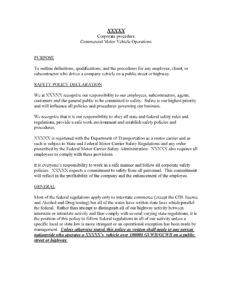A company vehicle use policy template is a formal document that outlines the regulations and procedures for employees who utilize company-owned or leased vehicles for business purposes. Its primary objective is to ensure responsible, safe, and efficient use of company vehicles while safeguarding the interests and assets of both the employer and employees.
Implementing a comprehensive company vehicle use policy template offers various advantages. It fosters accountability and responsibility among employees, minimizes the risk of vehicle misuse or accidents, and establishes clear guidelines for vehicle maintenance and repairs. Moreover, it helps employers manage costs associated with fleet operations and promotes a positive company image by ensuring vehicles are used professionally and ethically.
General Employee Obligations
Introduction: This section defines the general expectations and responsibilities of employees operating company vehicles. It sets the tone for the policy by emphasizing the importance of safety, compliance, and ethical behavior.
Vehicle Use: Clarify the authorized purposes for using company vehicles. Provide guidelines for personal use, such as commuting or running errands, and establish restrictions on non-business activities.
Driver Qualifications: Outline the requirements employees must meet to be eligible to operate a company vehicle, including possessing a valid driver’s license, maintaining a clean driving record, and undergoing necessary training.
Vehicle Safety: Emphasize the importance of safe driving practices, adherence to traffic regulations, and regular vehicle inspections to maintain roadworthiness and minimize the risk of accidents.
Vehicle Maintenance and Repair
Introduction: This section addresses the procedures for vehicle maintenance, repairs, and emergency situations to ensure the longevity and safety of company vehicles.
Preventive Maintenance: Define the responsibilities of employees in maintaining company vehicles, such as following recommended maintenance schedules for oil changes, tire rotations, and other routine inspections.
Repairs: Establish a clear process for reporting and authorizing vehicle repairs. Specify who is responsible for coordinating repairs, whether it’s an in-house mechanic or an authorized service center.
Emergency Situations: Provide instructions for employees to follow in the event of a vehicle breakdown or accident, including contacting the appropriate authorities, securing the vehicle, and reporting the incident to the company.
FAQ
What is the purpose of a company vehicle use policy template?
A company vehicle use policy template serves as a foundation for establishing clear guidelines, expectations, and procedures governing the use of company vehicles by employees. Its primary aim is to promote responsible and safe driving practices, minimize the risk of accidents, and ensure efficient management of vehicle maintenance and repairs.
Who should use a company vehicle use policy template?
A company vehicle use policy template is suitable for businesses and organizations that provide company vehicles to their employees for work-related purposes. It is particularly relevant for companies with a fleet of vehicles or those seeking to formalize and standardize their vehicle use policies.
What are the key elements of a company vehicle use policy template?
A comprehensive company vehicle use policy template typically includes sections addressing general employee obligations, vehicle maintenance and repair procedures, accident reporting guidelines, and personal use regulations. It outlines expectations for safe driving, compliance with traffic laws, regular vehicle inspections, and responsible vehicle maintenance practices.
In conclusion, a company vehicle use policy template plays a crucial role in fostering accountability and responsibility among employees while safeguarding the company’s assets. By establishing clear guidelines and procedures, companies can minimize risks, promote efficient fleet management, and ensure the safe and ethical use of company vehicles.
